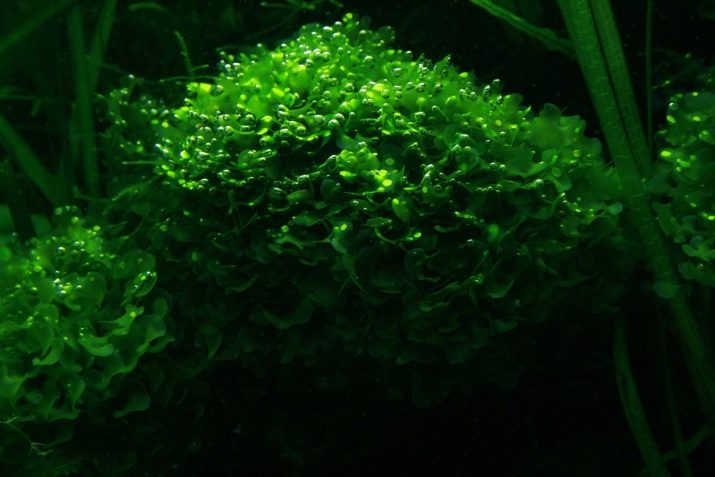An integral part of every aquarium, in addition to fish and decorative elements, is moss. To decorate the aquarium, various flowering aquatic plants or algae are bought at the pet store. However, after the lapse of time they may lose their brightness and beauty or not at all take root. A completely different matter is moss, which is not at all whimsical to care for and can live and reproduce in water for a long time. In this article, we will talk about the so-called hepatic, find out how to properly care for and plant it.

Description
Hepatic moss, otherwise floating riccia, known throughout the world, is very often used by both experienced aquarists and beginners to decorate.
Its shape resembles a glomerulus, the color of which is bright green in various shades.
Hepatic moss is characterized by rapid growth, thanks to which it covers the entire bottom of the aquarium. How quickly it grows is influenced by the conditions of its maintenance. This type of moss is unpretentious: it can withstand water temperatures above + 20ºС and intense lighting. But badly can affect the development of stagnant water in the aquarium. White spots and plaque that form on the branches can be a signal of the disease.

It is very important to monitor the condition of the plant, and if a disease is detected, you must immediately take action, otherwise it will die.
But it is also worth noting that under the influence of constant air currents, the growth rate of hepatic moss increases. therefore It is advisable to cover the aquarium with glass.
What is the advantage?
Before discussing the basic issues of planting and care, let's find out what is the advantage of a plant like moss over its analogues.
So, the advantages of the liverwort include:
- thanks to its bright color and interesting shape, it transforms the tank;
- guarantees the necessary mineral metabolism;
- constantly saturates water with the necessary volume of oxygen;
- plays the role of a filter;
- creates a shadow for the inhabitants of the tank;
- enables fish to build spawning nests;
- is the best medium for breeding the favorite dish of most fish - ciliates.

As you can see, liver moss in the aquarium brings many benefits to its inhabitants, makes their life more comfortable.
Preferred Neighborhood
If you decide that the liverwort will be grown in the aquarium, you must take care of the neighborhood before embarking on its planting.
Experts say that the plant is well compatible with various species of fish, plants and shellfish. Such a moss "gets along" perfectly with:
- guppies;
- molliesia;
- a barbecue;
- fighting cocks;
- by parsing.
It is strongly not recommended to plant the liver in the aquarium, where large individuals will dwell.


The branches of the plant are quite fragile, and large fish can damage them. As for algae, do not plant moss next to them in the same tank.
The growth rate of plants is so high that in a short period of time they grow to the entire reservoir and begin to interfere not only with each other, but also with the fish.
Landing
Hepatic moss reproduces both sexually and vegetatively.
The planting process in the new aquarium is quite straightforward. A piece of the plant that you have, and it can be purchased at the pet store, needs to be planted in a reservoir on the substrate.

The initial landing site for the aquarium may be stone, porous ceramics or other decorative element that is in the tank.
In order for the moss to take root and begin to grow, it is necessary to create favorable conditions for it.
- Water temperature should be within + 21 ... 28ºС.
- The aquarium should be clean.
- It is necessary to monitor the emergence of new shoots and stop them. This is necessary so that the old processes do not die out.
- Despite the fact that this plant can grow on any surface, it requires the presence of aquarium soil for full development. It's all about the presence of beneficial bacteria in it, taking part in gas exchange and cleaning the aquarium.
- Bryophytes need good lighting. That is why you need to control the amount of light.

Care
Caring for liver moss is pretty easy. Here are some mandatory rules and guidelines.
- Despite the absence of a root system, mosses still need minerals and fertilizers. Special liquid fertilizers that can be purchased at any pet store are well suited.
- Can be fed with phosphates and nitrates. These additives contribute to the formation of the required amount of carbon dioxide in water.
- Of great importance is clean and filtered water. This factor must be taken into account when choosing a filter for the aquarium - focus on the indicators of strength and uniformity of the flow of the mechanism.
- Do not forget to regularly change the water in the tank.
- Keep track of the volume of growth of new branches. Periodically, you need to trim them, giving the moss an aesthetic appearance.
The above listed rules for caring for bryophytes will make it possible to grow a beautiful plant that will become a real decoration of the aquarium and a cozy home for its abode.
See below for more details on this plant.










